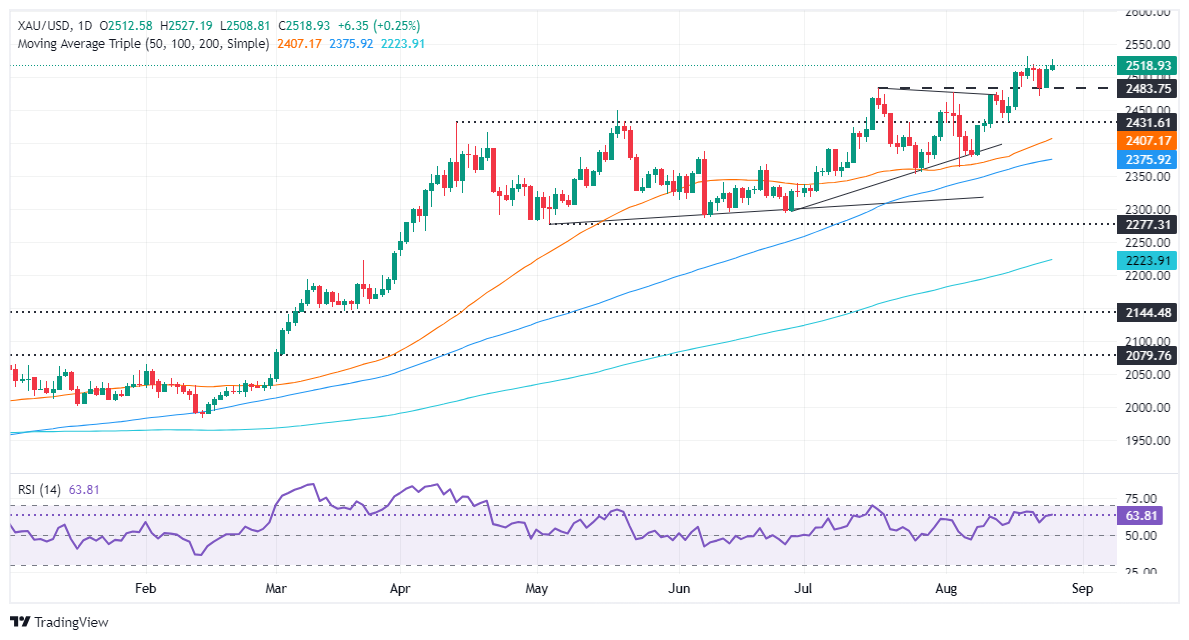- Gold rises post-Powell’s Jackson Hole comments on potential September policy easing.
- Powell cites inflation control, labor market concerns; Daly echoes rate cut expectations.
- US Durable Goods Orders jump 9.9% in July, showing economic strength; Middle East tensions boost Gold’s appeal.
- US 10-year yields reach 3.81%; traders scale back on 50 bps cut bets, await Nonfarm Payrolls for more insights.
Gold extended its gains on Monday amid increasing bets that the US Federal Reserve (Fed) will begin to ease policy in September. This is a certainty following Fed Chair Jerome Powell’s speech at Jackson Hole, when he said, “The time has come for policy to adjust.” The XAU/USD trades at $2,516 per troy ounce, up by a minimal 0.16%.
Last Friday, Jerome Powell said that he was confident that inflation was on its way toward the Fed’s 2% goal and expressed worries about a weaker labor market, indicating that employment risks were skewed to the upside.
Powell gave the green light on interest rate cuts, adding that further cooling in the labor market is unwelcome.
Powell’s comments were echoed by San Francisco Fed President Mary Daly, who said, “The time to adjust policy is upon us. It’s hard to imagine anything could derail a September rate cut.”
Daly added that it’s premature to know the size of interest rate cuts, yet stated that if the economy weakens “more than anticipated, we will need to be more aggressive.”
US Durable Goods Orders jumped from a -6.9% contraction in June to a 9.9% MoM expansion in July, exceeding the forecast for a 4% increase. This was the most significant gain since May 2020, hinting the economy is still resilient despite showing some signs of slowing down.
Bullion prices got a lifeline from rising tensions in the Middle East as the Israel-Hezbollah conflict escalated over the weekend. Fears that the conflict could broaden would be positive for the golden metal.
US Treasury bond yields had recovered as the US 10-year benchmark note climbed one basis point to 3.81%. Meanwhile, traders decreased their bets that the Fed would cut rates by 50 bps at the September meeting.
The CME FedWatch Tool shows that market participants had fully priced in a 25 bps cut, while odds for a larger size stand at 30%, down from 36.5 % last Friday.
Now, with the Fed shifting toward the jobs market, the August Nonfarm Payrolls report will be the last piece of the puzzle to determine the size of the cut.
Daily digest market movers: Gold price advances ahead of next week’s US inflation report
- If US economic data continues to be soft, the Gold price uptrend will remain, which would increase speculation about a bigger rate cut.
- On Tuesday, the US Conference Board will reveal Consumer Confidence for August, which is expected to improve from 100.3 to 100.6.
- Gross Domestic Product (GDP) figures for Q2 in the second estimate are expected to improve from 1.4% to 2.8%.
- On Friday, the Fed’s favorite inflation gauge, the Core Personal Consumption Expenditures (PCE) Price Index, will be revealed. It is expected to rise from 2.6% to 2.7% YoY.
Technical outlook: Gold’s uptrend is intact as buyers eye $2,550
Gold’s uptrend remains in play, yet buyers have failed to reclaim the all-time high (ATH) of $2,531. A breach of the latter will expose the $2,550 mark, followed by the $2,600 mark.
On the flip side, if Gold achieves a daily close below $2,500, this will sponsor a test of the previous all-time high (ATH) of $2,483. If surpassed, Gold’s next support would be the May 20 peak of $2,450, followed by the 50-day Simple Moving Average (SMA) at $2,406.
Fed FAQs
Monetary policy in the US is shaped by the Federal Reserve (Fed). The Fed has two mandates: to achieve price stability and foster full employment. Its primary tool to achieve these goals is by adjusting interest rates. When prices are rising too quickly and inflation is above the Fed’s 2% target, it raises interest rates, increasing borrowing costs throughout the economy. This results in a stronger US Dollar (USD) as it makes the US a more attractive place for international investors to park their money. When inflation falls below 2% or the Unemployment Rate is too high, the Fed may lower interest rates to encourage borrowing, which weighs on the Greenback.
The Federal Reserve (Fed) holds eight policy meetings a year, where the Federal Open Market Committee (FOMC) assesses economic conditions and makes monetary policy decisions. The FOMC is attended by twelve Fed officials – the seven members of the Board of Governors, the president of the Federal Reserve Bank of New York, and four of the remaining eleven regional Reserve Bank presidents, who serve one-year terms on a rotating basis.
In extreme situations, the Federal Reserve may resort to a policy named Quantitative Easing (QE). QE is the process by which the Fed substantially increases the flow of credit in a stuck financial system. It is a non-standard policy measure used during crises or when inflation is extremely low. It was the Fed’s weapon of choice during the Great Financial Crisis in 2008. It involves the Fed printing more Dollars and using them to buy high grade bonds from financial institutions. QE usually weakens the US Dollar.
Quantitative tightening (QT) is the reverse process of QE, whereby the Federal Reserve stops buying bonds from financial institutions and does not reinvest the principal from the bonds it holds maturing, to purchase new bonds. It is usually positive for the value of the US Dollar.






